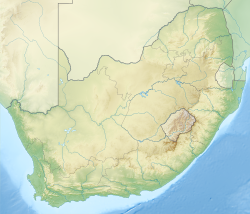| Sterkfontein Dam | |
|---|---|
 Sterkfontein Dam Reservoir seen from the R74 | |
| Official name | Sterkfontein Dam |
| Location | Free State |
| Coordinates | 28°26′54″S29°01′22″E / 28.4484°S 29.0228°E |
| Construction began | 1969 |
| Opening date | 1980 (renovated 1986) [1] |
| Dam and spillways | |
| Type of dam | Earth fill dam |
| Impounds | Nuwejaarspruit [1] |
| Height | 97 metres (320 ft) [1] |
| Length | 3,060 metres (3,350 yd) [1] |
| Dam volume | 19,800,000 m3 (25,900,000 cu yd) |
| Spillway capacity | 0 m3/s (0 cu ft/s) |
| Reservoir | |
| Creates | Sterkfontein Dam Reservoir |
| Total capacity | 2,616,000 ML (2,121,000 acre⋅ft) [1] |
| Catchment area | 195 km2 (75 sq mi) |
| Surface area | 69.37 km2 (26.78 sq mi) [1] |
| Maximum length | 18.8 km (11.7 mi) |
| Normal elevation | 1,708 m (5,604 ft) |
The Sterkfontein Dam, located just outside the town of Harrismith, in the Free State, province of South Africa, is part of the Tugela-Vaal Water Project and the Drakensberg Pumped Storage Scheme, and located on the Nuwejaarspruit, a tributary of the Wilge River in the upper catchment area of the Vaal River. [2] It is the second highest dam wall in South Africa and its highest earth fill dam.
















